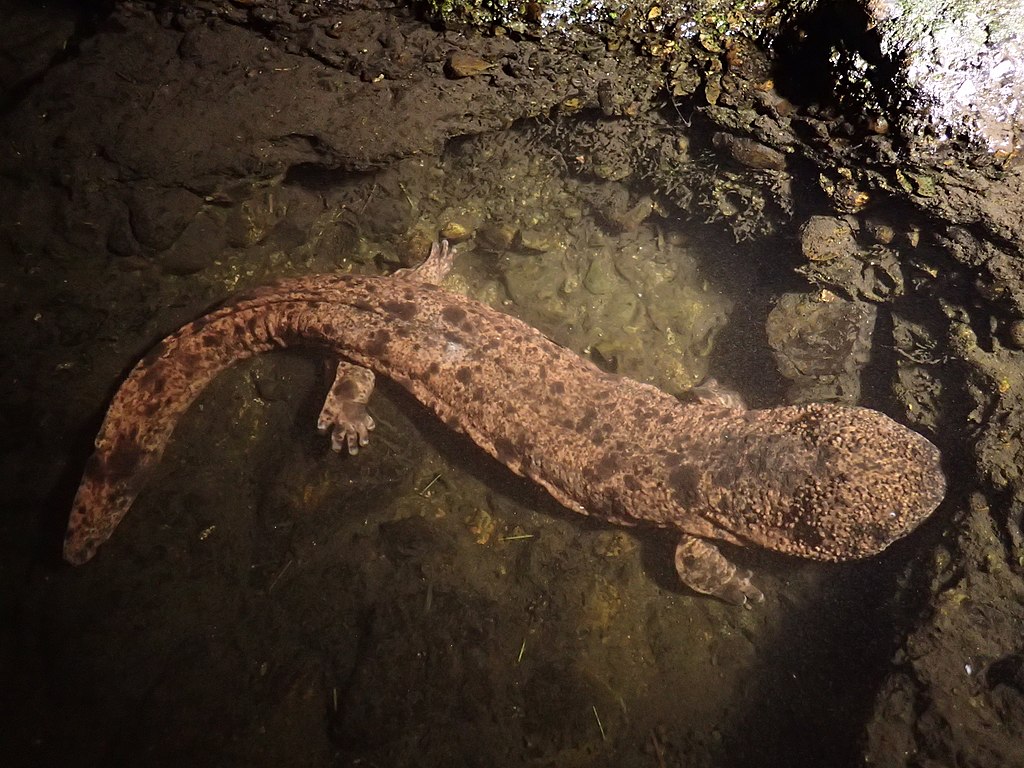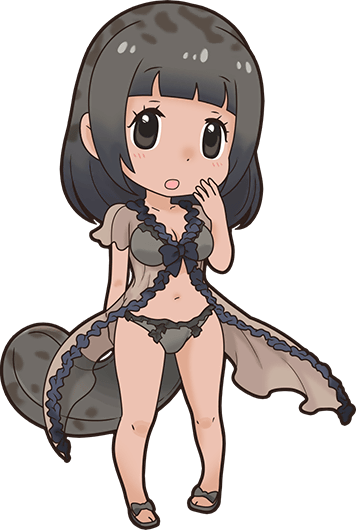Japanese Giant Salamander: Difference between revisions
No edit summary |
KenjiDraco (talk | contribs) No edit summary |
||
| (22 intermediate revisions by 5 users not shown) | |||
| Line 1: | Line 1: | ||
{{FriendBox | {{FriendBox | ||
|name=Japanese Giant Salamander | |name=Japanese Giant Salamander | ||
|originalpic=Japanese Giant SalamanderOriginal. | |originalpic=Japanese Giant SalamanderOriginal.png | ||
|name_jp=オオサンショウウオ | |name_jp=オオサンショウウオ | ||
|name_rm=Ōsanshō̄o | |name_rm=Ōsanshō̄o | ||
| Line 8: | Line 8: | ||
|distribution=southwestern Japan | |distribution=southwestern Japan | ||
|diet=Carnivore | |diet=Carnivore | ||
|lifespan=Nearly 80 years | |||
|wikilink=[[wikipedia:Japanese giant salamander|Japanese giant salamander]] | |wikilink=[[wikipedia:Japanese giant salamander|Japanese giant salamander]] | ||
|conservationstatus={{ | |conservationstatus={{VU}} | ||
}} | }} | ||
{{FriendBuilder | {{FriendBuilder | ||
|introduction='''Japanese Giant Salamander''' is a type of [[Friend]] that appeared in the original Kemono Friends mobile game. | |introduction='''Japanese Giant Salamander''' is a type of amphibian [[Friend]] that appeared in the original [[Kemono Friends (2015 Mobile Game)|Kemono Friends mobile game]]. | ||
| | |appearance=Japanese Giant Salamander has smooth greyish brown hair at medium length with dark patches. She has a dark eye color similar to her hair. She has a thick dark tail with a round end. She is in a greenish grey bikini with dark ruffles resembling the skin folds of her species. On top she wears an open, pinkish see-through sleep gown with dark ruffles. She is wearing dark sandals with a ribbon on them. At the back there is a long thick tail with coloration like the original animal. | ||
|t0=No | |||
|t1=Yes | |||
|nxnrole=Minor character, playable character | |||
|t2=No | |||
|t3=No | |||
|t4=No | |||
|t5=No | |||
|t6=No | |||
|t7=No | |||
|t8=No | |||
|t9=No | |||
|t10=No | |||
|t11=No | |||
|t12=No | |||
|t13=No | |||
|t14=No | |||
|t15=No | |||
|t16=No | |||
|t17=No | |||
|t18=No | |||
|t19=No | |||
|t20=No | |||
|t21=No | |||
|t22=No | |||
|t23=No | |||
|t24=No | |||
|t25=No | |||
|t26=No | |||
|t27=No | |||
|t28=No | |||
|reallife=Japanese giant salamander is a species of aquatic salamander living exclusively in freshwater rivers and streams of southwestern Japan. It is the third-largest salamander in the world with a length of up to 1.5m (5 feet). It is a special natural monument in Japan and is protected by law. | |||
[[File:Japanese_giant_salamander_01.jpeg|thumb|upright=1.0|left|A Japanese giant salamander in Tottori Prefecture, Japan. Photo by [https://commons.wikimedia.org/wiki/File:Japanese_giant_salamander_in_Tottori_Prefecture,_Japan.jpg Salamandra2021].]] | |||
The | The species has a brown and black mottled skin as camouflage against the riverbeds. Its skin has large folds at its neck to help breathe through skin more effectively. Its body surface is covered with many small warts. It has very tiny eyes with poor eye sight and a wide mouth extends across the width of its head. On each jaw there are 2 rows of tiny teeth. Each of its front leg have 4 toes while its hind legs have 5. Its primary diet includes crabs, frogs, and fish. It has a very low metabolic rate and can survive without eating for weeks. It has a long lifespan with records of 52 years in captivity and nearly 80 years in the wild. | ||
The | During Summer, a strong male called "nushi" (ヌシ) secures a cave or crevice favorable for breeding to attract females to visit. The nushi can gather 300 to 700, or even up to 1000 eggs. The nushi guards the eggs for 3 to 4 months until they hatch, which is around October and November. | ||
The amphibian is considered Vulnerable by IUCN. Water pollution, habitat loss, invasive species and manmade structures along rivers are the major threats. Concrete banks and dams in particular has serious impact to its survival as they destroyed its nesting sites and block migration paths respectively. Another serious threat is the [[wikipedia:Hybrid (biology)|hybridisation]] with [[wikipedia:Chinese Giant Salamander|Chinese Giant Salamander]], an invasive species introduced back in 1970s as a food source and released into the wild. The existence of the hybrid has greatly reduced the population of the native one. In [[wikipedia:Kamo River|Kamo River]] of [[wikipedia:Kyoto|Kyoto]], the hybrid currently takes up about 80% of the populations while the Japanese Giant Salamander is estimated to be only 10%. | |||
Though Japanese Giant Salamanders live in streams or rivers away from human, sometimes they may appear or get washed downstream to man-made waterways during rainy seasons. There have been sightings of them in rivers within urban areas of Kyoto and Hiroshima. | |||
|trivia=* The species's Japanese name (山椒魚) came from the name of [[wikipedia:Zanthoxylum piperitum|Japanese pepper]] (山椒, sanshō). | |||
* Japanese giant salamander is worshipped at a shrine in the city Maniwa, Okayama Prefecture, Japan. A festival is held to honor the giant amphibian on 8th August every year in the same city. | |||
* The Kyoto Zoo is one of the few places that exhibits purebred Japanese Giant Salamander. | |||
|reference=* [https://www.kyoto-aquarium.com/en/index.html Kyoto Aquarium] - Japanese Giant Salamander exhibition. | |||
* Sustainable Daisen, a NGO in Japan holding campaigns in an effort to conserve of Japanese giant salamanders and their habitats https://www.sustainabledaisen.org/en/about-sustainable-daisen | |||
}} | }} | ||
{{AmphibianFriendsNav}} | {{AmphibianFriendsNav}} | ||
[[Category:Real Animal Friends]] [[Category:Amphibian Friends]] [[Category:Nexon Game Debuts]] | |||
Latest revision as of 07:45, 2 June 2024
Japanese Giant Salamander
| |||
|---|---|---|---|
| オオサンショウウオ | |||
| Character Data | |||
| Romaji | Ōsanshō̄o
| ||
| Debut | Kemono Friends (2015 Game) | ||
| Animal Data | |||
| Scientific Name | Andrias japonicus
| ||
| Distribution | southwestern Japan
| ||
| Diet | Carnivore
| ||
| Avg. Lifespan | Nearly 80 years
| ||
| Read More | Japanese giant salamander
| ||
| Conservation | 
| ||
| Japanese Giant Salamander | Nexon Game |
Japanese Giant Salamander is a type of amphibian Friend that appeared in the original Kemono Friends mobile game.
Appearance
Japanese Giant Salamander has smooth greyish brown hair at medium length with dark patches. She has a dark eye color similar to her hair. She has a thick dark tail with a round end. She is in a greenish grey bikini with dark ruffles resembling the skin folds of her species. On top she wears an open, pinkish see-through sleep gown with dark ruffles. She is wearing dark sandals with a ribbon on them. At the back there is a long thick tail with coloration like the original animal.
Series Appearances
| Media | Role | |
|---|---|---|
| 2015 | Nexon Game | ↪ Minor character, playable character |
In Real Life
Japanese giant salamander is a species of aquatic salamander living exclusively in freshwater rivers and streams of southwestern Japan. It is the third-largest salamander in the world with a length of up to 1.5m (5 feet). It is a special natural monument in Japan and is protected by law.

The species has a brown and black mottled skin as camouflage against the riverbeds. Its skin has large folds at its neck to help breathe through skin more effectively. Its body surface is covered with many small warts. It has very tiny eyes with poor eye sight and a wide mouth extends across the width of its head. On each jaw there are 2 rows of tiny teeth. Each of its front leg have 4 toes while its hind legs have 5. Its primary diet includes crabs, frogs, and fish. It has a very low metabolic rate and can survive without eating for weeks. It has a long lifespan with records of 52 years in captivity and nearly 80 years in the wild.
During Summer, a strong male called "nushi" (ヌシ) secures a cave or crevice favorable for breeding to attract females to visit. The nushi can gather 300 to 700, or even up to 1000 eggs. The nushi guards the eggs for 3 to 4 months until they hatch, which is around October and November.
The amphibian is considered Vulnerable by IUCN. Water pollution, habitat loss, invasive species and manmade structures along rivers are the major threats. Concrete banks and dams in particular has serious impact to its survival as they destroyed its nesting sites and block migration paths respectively. Another serious threat is the hybridisation with Chinese Giant Salamander, an invasive species introduced back in 1970s as a food source and released into the wild. The existence of the hybrid has greatly reduced the population of the native one. In Kamo River of Kyoto, the hybrid currently takes up about 80% of the populations while the Japanese Giant Salamander is estimated to be only 10%.
Though Japanese Giant Salamanders live in streams or rivers away from human, sometimes they may appear or get washed downstream to man-made waterways during rainy seasons. There have been sightings of them in rivers within urban areas of Kyoto and Hiroshima.
Trivia
- The species's Japanese name (山椒魚) came from the name of Japanese pepper (山椒, sanshō).
- Japanese giant salamander is worshipped at a shrine in the city Maniwa, Okayama Prefecture, Japan. A festival is held to honor the giant amphibian on 8th August every year in the same city.
- The Kyoto Zoo is one of the few places that exhibits purebred Japanese Giant Salamander.
References
- Kyoto Aquarium - Japanese Giant Salamander exhibition.
- Sustainable Daisen, a NGO in Japan holding campaigns in an effort to conserve of Japanese giant salamanders and their habitats https://www.sustainabledaisen.org/en/about-sustainable-daisen
| Amphibian Friends | ||
|---|---|---|
| Axolotl • Hellbender • Japanese Giant Salamander • Northern Dwarf Siren | ||
